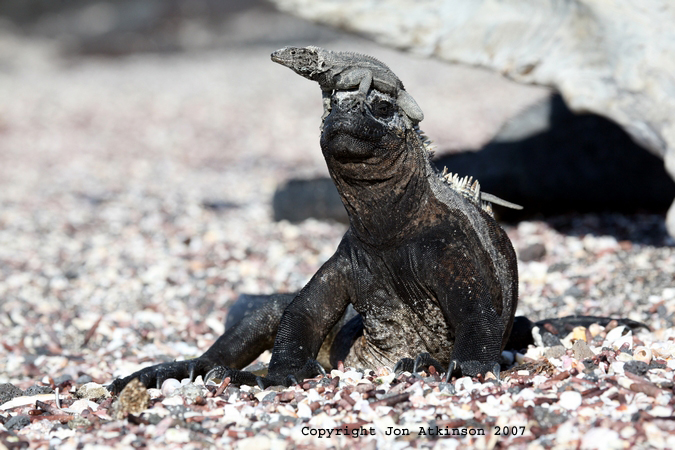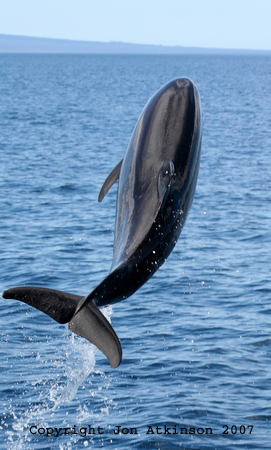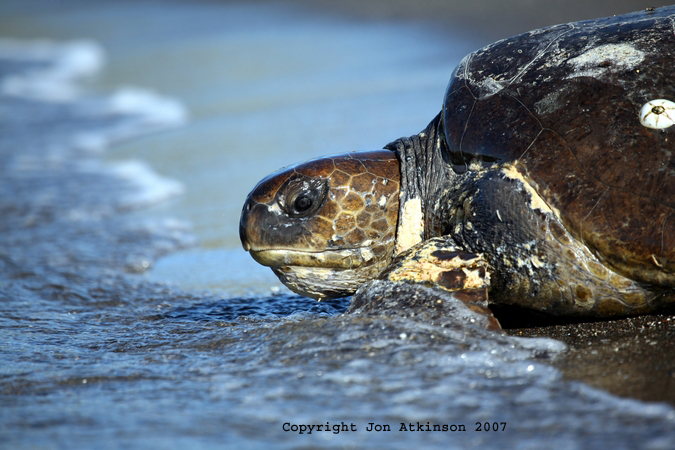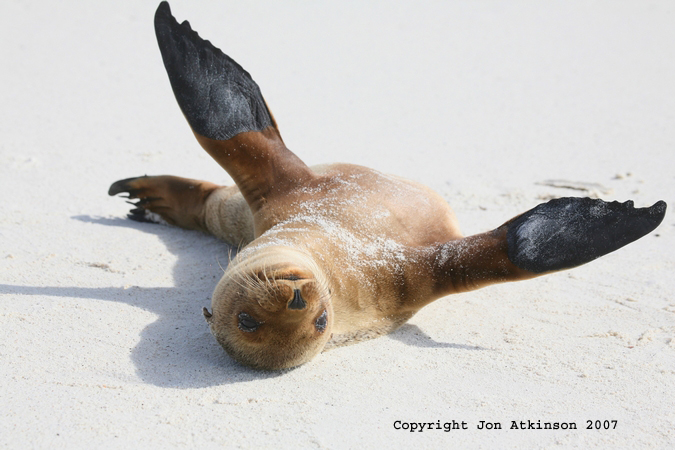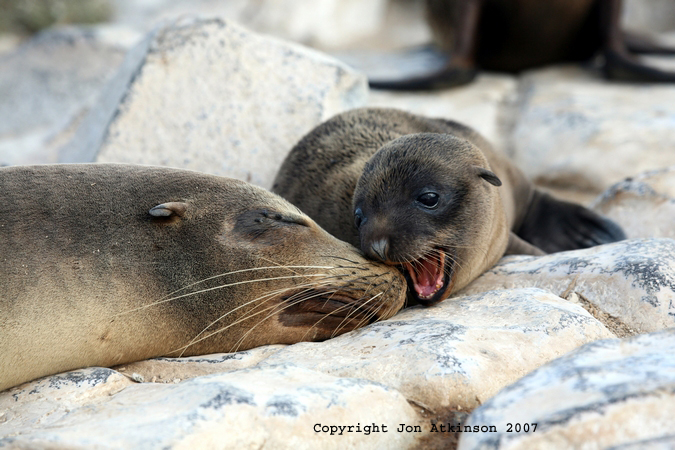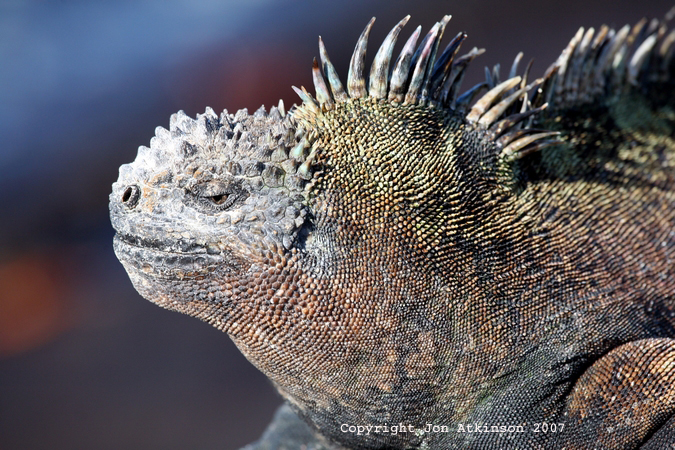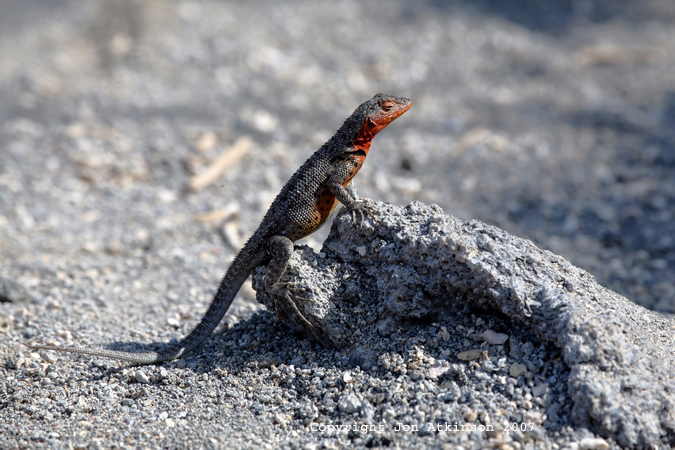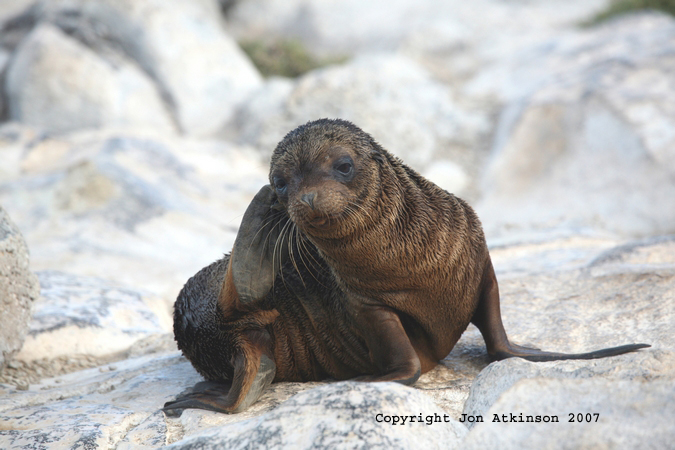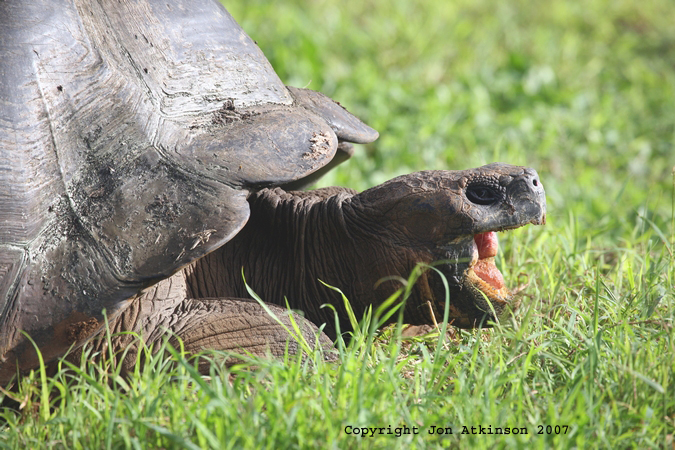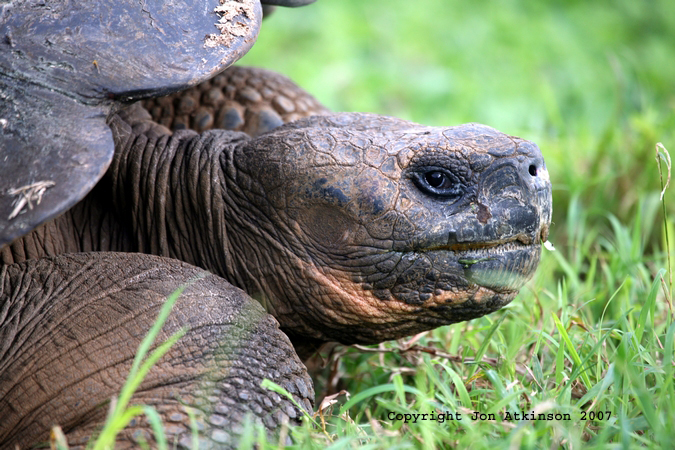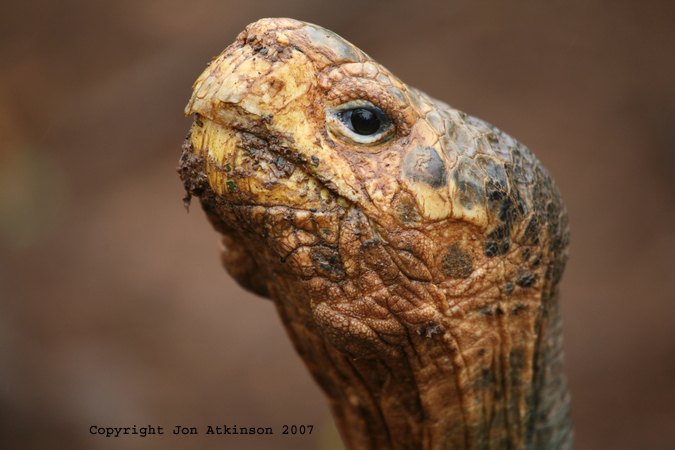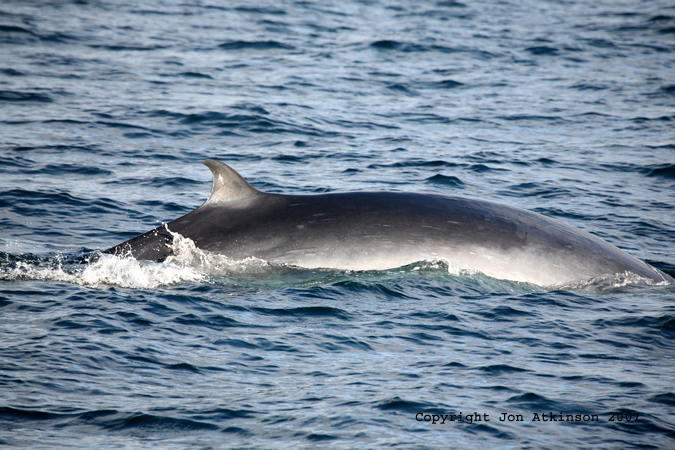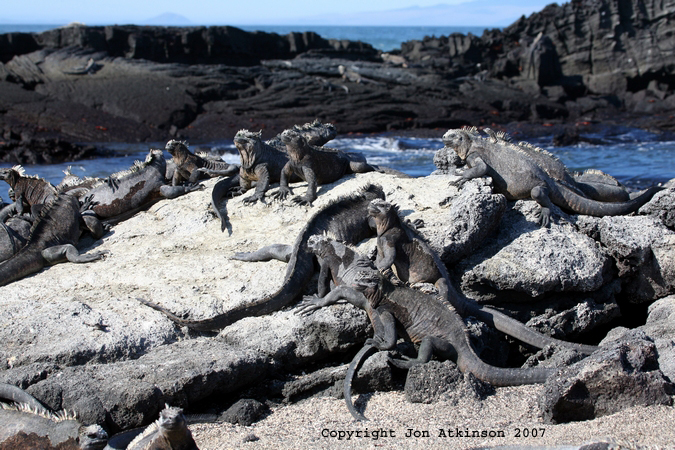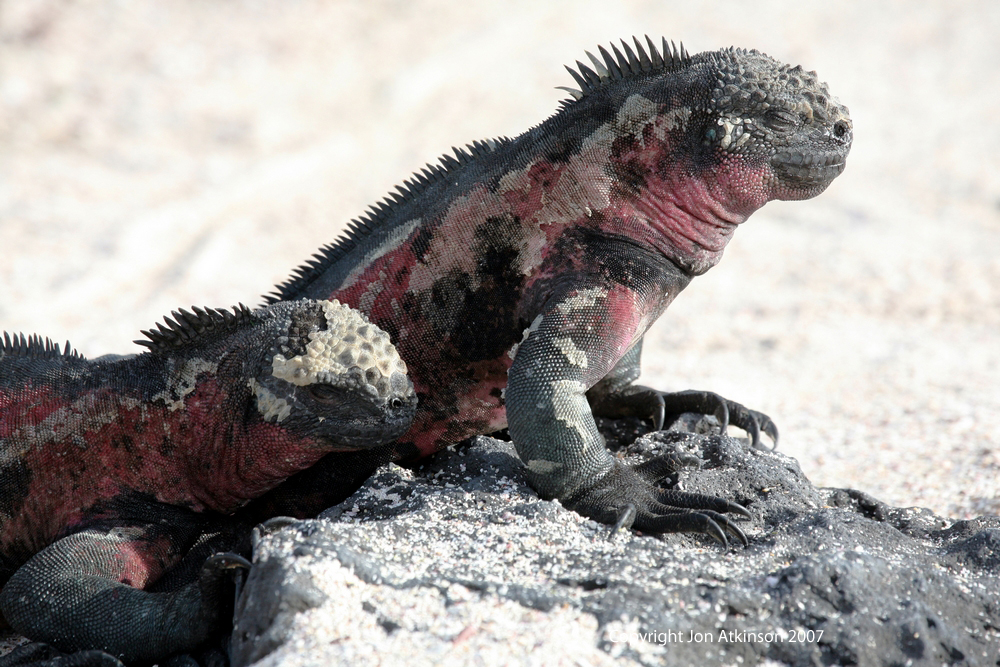GALAPAGOS WILDLIFE 1 - A Lava lizard finds a Galapagos Iguana's head a convenient place to bask: Iguana is the common name for a large new world lizard. They have distinctive eyelids, external eardrums, throat pouches, each limb has 5 toes with sharp claws allowing them to climb. Unlike most lizards, iguanas are vegetarians. |
GALAPAGOS WILDLIFE 2 - A bottlenose dolphin leaps into the air, Isla Fernandina: The bottlenose dolphin is perhaps one of the most well known cetaceans, because of its widespread use in marine parks and research facilities. The color of the bottlenose dolphin varies considerably, but generally this dolphin is light gray to slate gray on the upper part of the body shading to lighter sides and pale, pinkish gray on the belly. |
GALAPAGOS WILDLIFE 3 - Green Sea Turtle enters the water after a trip on shore, Isla Isabella: WUnlike other species, Green Turtles are found in all temperate and tropical waters throughout the world. The Green Sea Turtle is the largest hard-shelled sea turtle in the world. It ranges in length from 2 to 6 feet with males averaging a little larger than females and weigh on average 200 kilograms. |
GALAPAGOS WILDLIFE 4 - Galapagos sea lion stretches on the beach: Galapagos islands sea lion are fin-footed mammals with amazing abilities in water. Adult males known as bulls are the head of the colony. Bulls grow to be up to 7 feet (2 meters) in length and 800 lbs (363 kg).
| GALAPAGOS WILDLIFE 5 - Green Sea Turtle enters the water after a trip on shore, Isla Isabella: Whilst green sea turtles are eating, they stay under water for up to10 minutes. When they are resting, they can remain underwater for 2 and a half hours without the need to surface. The turtles' favorite food is sea grass and mangrove leaves however their diet can be varied to include jellyfish, algae, shrimp, and crustaceans. |
GALAPAGOS WILDLIFE 6 - Galapagos Sea Lion cow and pup: Each cow has a single pup born a year after conception. The pups have a strong bond with their mother. The cow will nurture a pup for up to three years. In that time the cow and the pup will recognize each other's bark from the rest of the colony. When the pup is 2 - 3 weeks old the cow will mate again.
|
GALAPAGOS WILDLIFE 8 - Male lava lizard in full breeding plumage, Isla Fernandina: There are seven different species of Tropidurus, lava lizards, found in the Galápagos. The male lava lizard is larger then the female and they look distinctly different. The overall color patterns are different, and females have bright red skin under their throats. The males are territorial and will protect their territories from other males. |
GALAPAGOS WILDLIFE 9 - Young Galapagos Sea Lion: The Galapagos sea lions are common in the islands where there are sandy beaches and gentle rocky shores. It is estimated that there are about 50,000 individuals. Their food is mainly fish for which they will often make extended trips away from the colony. |
|
GALAPAGOS WILDLIFE 10 - Galapagos Giant Tortoise, Isla Santa Cruz: The Galapagos Islands are named for the 250,000 giant tortoises that lived on the islands - 'galapagos' in Spanish means saddle and refers to the tortoise shell. Today, only 15,000 of these giants are left. |
GALAPAGOS WILDLIFE 11 - Galapagos Giant Tortoise, Isla Santa Cruz: Giant Tortoise's grow for 30 to 40 years, reaching almost five feet. They also weigh about 500 pounds. These are the largest tortoises in the world. In general, they are the longest living of all vertebrates. The oldest giant tortoise on record lived 152 years. Reliable records of tortoise life spans aren't available yet because people haven't been observing them long enough. |
GALAPAGOS WILDLIFE 12 - Pinta Galapagos Tortoise, Charles Darwin Research Center, Isla Santa Cruz: "Lonesome George" is probably the last giant Pinta tortoise. Since George was discovered in 1971, there have been many attempts to get him to reproduce. Before the first ship sailed into the Galapagos archipelago in 1535, it was home to at least 15 distinct populations of giant tortoise. There were 15 subspecies, although only 11 still exist today. They have become extinct because of over hunting, and the introduction of goats, pigs, dogs and other animals which trample or eat the tortoise eggs and compete for food.. |
GALAPAGOS WILDLIFE 13 - Bryde's Whale, Isla Fernandina: The adult male Bryde's whale measures 12.2 to 15.2 meters (40 to 50 feet) and weights about 13 tons. They have a bluish-gray body with white on the underside. Some of them have dark gray or almost white scars that may be caused by bites of lampreys (fish that attach themselves to the whale and bore into the flesh). |
GALAPAGOS WILDLIFE 14 - Marine Iguanas, Isla Fernandina: The marine iguana only exists on the volcanic islands of the Galapagos and can grow up to 1 meter in length. They have developed into proficient swimmers which allows them to feed offshore. |
GALAPAGOS WILDLIFE 15 - Marine Iguanas, Isla Fernandina: The Galapagos marine iguana feeds almost entirely on algae (seaweed) that it finds between the tide-lines or below the sea's surface. Whether above or below the sea, the food consists of small red or green algae. To cope with the high salt intake in its diet, the Galapagos marine iguana must excrete salt. It has salt glands located above the eye and are connected via a duct to the nostrils. |

